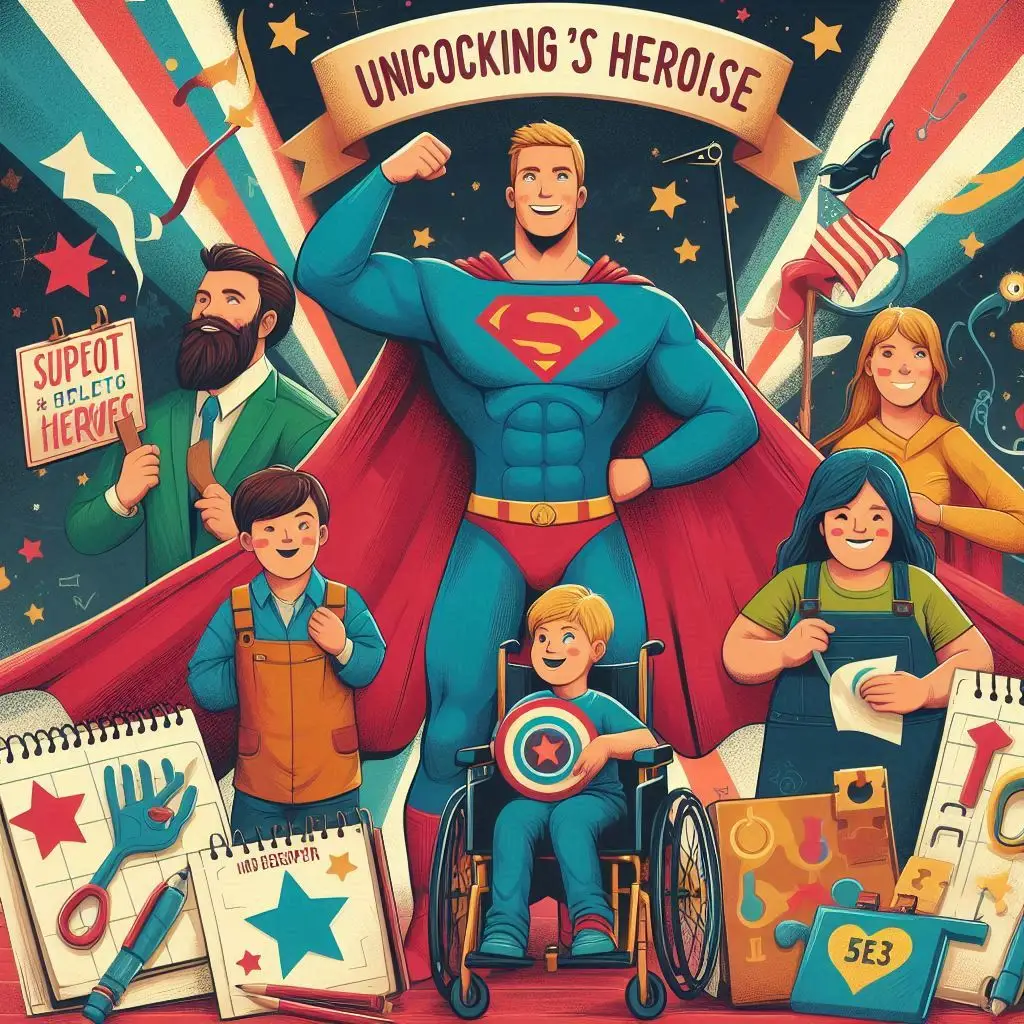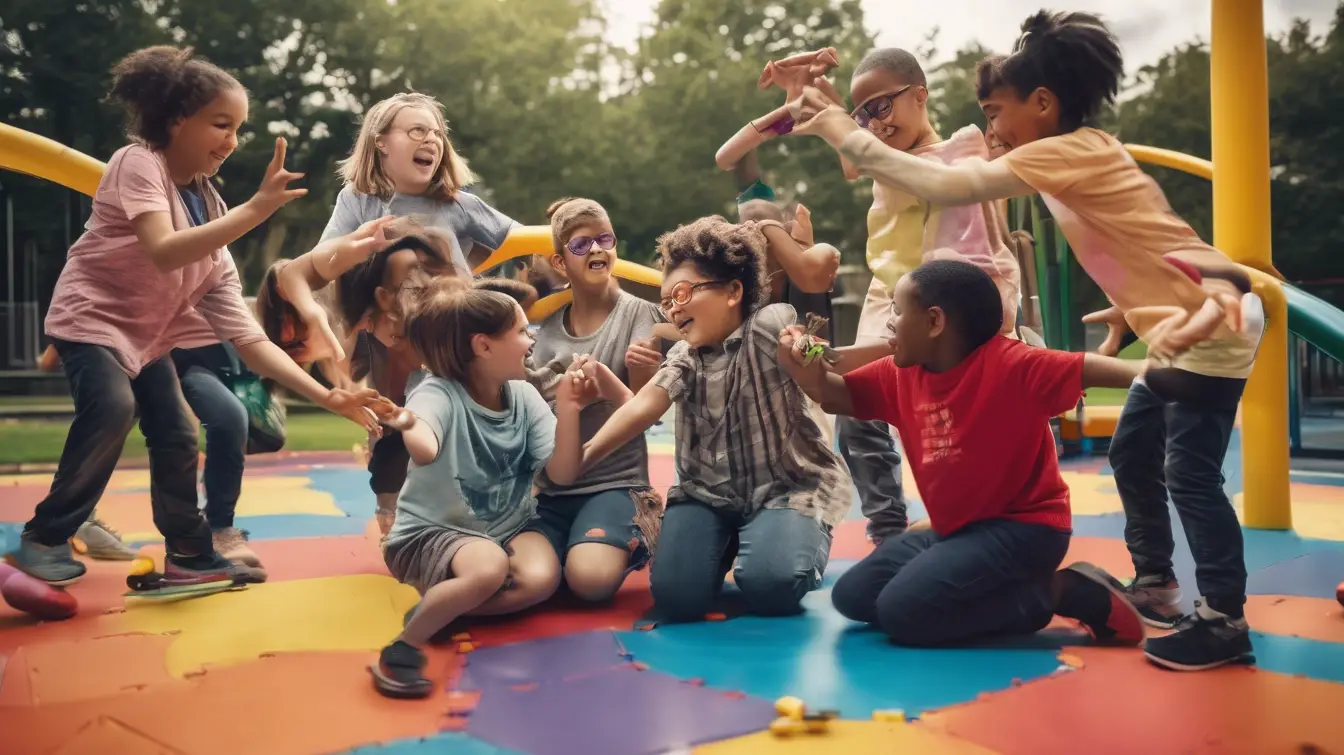Discover how aiding special needs children empowers you as a real-life hero in their lives and beyond, truly embodying the essence of Unlocking Heroism.
By embracing the concept of Unlocking Heroism, we can inspire children and ourselves to reach new heights.

“How Unlocking Heroism Impacts Children: A Deeper Dive”
“The Secret Superpower: Why Assisting Children with Special Needs Makes You a Real-Life Hero in Unlocking Heroism”
Table of Contents

Unlocking Heroism: 5 Ways to Support Children with Special Needs and Enhance Their Heroism
Every child with special needs has the chance to be a hero in their own story. Unlocking Heroism can change how we see and help these kids.

Unlocking Heroism through Empathy and Understanding
Unlocking Heroism: Key Takeaways for Support
Unlocking Heroism for Special Needs Support, Real-Life Heroes and Special Needs
Traditional views often focus on what kids can’t do. Unlocking Heroism helps shift that perspective, allowing us to see what they can do and how we can help them grow.
Key Takeaways
Unlocking Heroism involves recognizing each child’s unique path and strengths.
- Heroism starts with recognizing the strengths of special needs heroes.
- Five actionable steps reframe support as empowerment, not just assistance.
- Strength-based approaches boost confidence and independence.
- Everyday interactions shape a child’s belief in their potential.
- Unlocking heroism for special needs support benefits the entire community.
Understanding the Journey of Special Needs Children in Unlocking Heroism
Every child with special needs has a unique path. It’s shaped by challenges and hidden strengths. Learning about their daily life can help you support them better.

Understanding these journeys is crucial for Unlocking Heroism and supporting their needs effectively.
children with special needs empowerment
Common Challenges Faced by Children with Special Needs
Many face barriers that limit their potential. Here are some daily obstacles:
- Social barriers: Struggles with peer relationships or bullying
- Educational hurdles: Inadequate classroom accommodations
- Accessibility issues: Physical environments or tools not designed for their needs
The Unique Strengths That Often Go Unnoticed
| Strength | Example |
| Persistence | Repeating a task 10 times to achieve mastery |
| Creative problem-solving | Adapting toys into assistive tools |
| Empathy | Understanding others’ feelings intuitively |
Why the Heroism Framework Matters in Special Needs Support
Seeing their journey through a heroism for special needs lens changes everything. It turns struggles into adventures. This view boosts special needs empowerment by:
- Highlighting resilience as a superpower
- Shifting focus from limitations to capabilities
- Building self-worth through achievement narratives
Seeing their daily victories as heroic acts changes how you see their growth.
The Power of Recognizing Potential in Special Needs Heroes
Every child with special needs has hidden strengths waiting to be found. Studies show that when we focus on what they can do, they often do more than we expect. A 2023 study in the Journal of Child Development found that kids seen as capable hit 30% more milestones than those in strict programs. Belief in potential becomes the first step in unlocking it.
“Potential is not a fixed trait—it’s shaped by the environment we create.” – Dr. Elena Torres, child psychologist

Unlocking Heroism: Empowering Children with Special Needs
- Watch for patterns in daily interactions: Does your child focus intently on music, puzzles, or helping others?
- Try adaptive activities outside traditional settings—art, coding clubs, or animal-assisted therapy—to reveal untapped skills.
- Track progress using non-academic metrics like problem-solving persistence or emotional resilience.
By Unlocking Heroism, we ensure that children are recognized for their true potential and capabilities.
Setbacks are part of growth. Instead of saying “They can’t,” ask “How can we adjust?” This mindset keeps support for special needs heroes aligned with realistic yet encouraging goals. A Stanford University model shows that 78% of children thrive when adults balance high expectations with flexible strategies.
Recognizing potential isn’t just kind—it’s the foundation for building the tailored strategies coming in later sections. When you see capability first, you empower children to see it in themselves too.
Unlocking Heroism for Special Needs Support: A Practical Approach
Every child deserves a place to thrive. Start by unlocking heroism for special needs support with real steps. These steps help kids grow and meet their unique needs.

Unlocking Heroism for Special Needs Support
Creating Safe Spaces for Self-Expression
Make places that feel safe and easy to get around. Use soft lights, materials that block noise, and visual plans. Give tools like picture boards or tablets with speech apps. For example, a classroom with quiet areas and AAC devices lets kids share their thoughts easily.
Building Confidence Through Tailored Challenges
Confidence comes from challenges that fit your skills. Follow these steps:
Unlocking Heroism plays a significant role in empowering children and enhancing their experiences.
Creating safe spaces is essential in Unlocking Heroism for children with special needs.
- Find out what you can do with help from experts.
- Make big goals into smaller steps. For instance, start with big laces for tying shoes.
- Make tasks harder little by little, praising effort and progress.
Unlocking Heroism requires us to build confidence through tailored challenges and support.
Celebrating Small Victories as Heroic Moments
“Celebration isn’t just praise—it’s recognition of effort as bravery.” – Dr. Emily Carter, child psychologist
Focus on progress with specific words of encouragement. Try these ways:
- Use charts to track progress.
- Have weekly “hero moments” where kids share their wins.
- Pair words of praise with small rewards like stickers or certificates.
| Strategy | Example | Benefit |
| Sensory-friendly rooms | Adjust lighting and textures | Reduces anxiety, boosts focus |
| Customized learning paths | Adjust math games to include tactile elements | Builds competence and confidence |
Adaptive Technologies: Tools That Transform Limitations into Superpowers
Technology is more than a tool; it’s a path to new possibilities. It includes speech-generating devices and sensory aids. These tools help children overcome obstacles and reach their full potential. They are key in special needs empowerment and raising special needs awareness in our daily lives.
Game-Changing Devices for Different Abilities
Let’s look at tools made for specific needs:
- Communication: Devices like Grid 3 by Inclusive Technologies turn gestures into words.
- Mobility: Rifton electric wheelchairs offer customizable control.
- Learning: First Then Visual Schedule apps help organize daily tasks visually.
- Sensory Processing: Abiliti Toys weighted vests and noise-canceling headphones provide calming input.
How Technology Fosters Independence and Confidence
Adaptive tools do more than help; they teach. When a child uses a voice-output device to ask for help, they gain control. Here are key findings from over 600 case studies:
| Technology Type | Impact | Example |
| Eye-tracking systems | Enhanced communication | Tobii Dynavox EyeMax aids nonverbal children |
| Adaptive switches | Improved motor skill engagement | AbilityNet’s touch-sensitive buttons |
Success Stories: When the Right Tool Makes All the Difference
“My son’s tablet with AAC apps turned frustration into conversations. Now he leads his own IEP meetings.” – Parent testimon
Tools like Proloquo2Go have helped many children in classrooms. When choosing devices, consider:
- Specific needs assessment
- Accessibility of funding (check Abilitech grants)
- Training for caregivers
Every device is a step toward inclusion. It shows that special needs awareness is about seeing potential, not limitations.
Building a Support Network: Your Role in the Special Needs Community
Your journey to special needs community engagement begins with finding the right people. Every connection helps build a stronger care circle around a child. This turns individual efforts into a collective force for good. Look for educators, therapists, and family members who want the same things as you.
- Join local parent groups or online forums to share insights and resources.
- Partner with schools to align IEP goals with home support strategies.
- Attend community workshops hosted by organizations like Easterseals or the Autism Society.
- Advocate for inclusive policies in your neighborhood parks, libraries, and schools.
“True heroism emerges when communities work as a unified team.” – Dr. Temple Grandin, autism advocate
| Strategy | Online Tools | Offline Actions |
| Resource Sharing | Join Special Needs Parent Hub on Facebook | Host a monthly resource exchange at local libraries |
| Advocacy | Create a shared Google Doc for school updates | Organize town halls with school boards |
Your role is not just to watch; it’s to connect the dots. By working together, you’re not just helping; you’re part of a powerful network. Every shared idea, online or in person, makes a difference. Begin with something small, like attending a workshop or joining an online group. The impact starts with you.
Real-Life Heroes and Special Needs: Inspiring Stories of Triumph
Meet the real-life heroes and special needs pioneers who change what’s possible. Their stories show that challenges can lead to new talents. Courage and creativity turn obstacles into opportunities.
Children Who Redefined What’s Possible
Take 12-year-old Mia, a girl with autism who paints amazing murals. Her art, shown in galleries, started as a way to deal with loud sounds. Meanwhile, 15-year-old Liam, who uses a wheelchair, created an app to help others with mobility issues navigate schools.
These real-life heroes for special needs show how being different can lead to innovation.
How Adversity Shaped Their Unique Strengths
- Autism’s sensory sensitivity became Mia’s artistic lens.
- Liam’s mobility limitations inspired tech solutions for accessibility.
- Nonverbal advocate Aisha uses sign language to lead workshops on inclusion.
Each story shows how challenges can highlight hidden talents.
Lessons from Young Heroes
These heroes teach us to:
- See differences as strengths, not deficits.
- Provide tools tailored to individual needs—like Liam’s coding classes or Aisha’s communication devices.
- Celebrate every milestone, no matter how small.
“My son’s dyslexia didn’t stop him—it pushed him to invent a spelling app. Heroes don’t avoid barriers; they redesign them.” – Parent of a nonverbal inventor
These stories remind us that heroism is about thriving uniquely. Their journeys show us how to build resilience in every child.
Advocacy as Heroism: Becoming a Voice for Special Needs Awareness
Advocacy turns simple actions into heroic deeds. By supporting special needs advocacy, you help change systems. This empowers kids and communities. Begin by finding out where support is lacking.
Look at school resources and healthcare access. Ask what daily challenges families face. Your findings will lead to meaningful actions.
- Join coalitions like the Autism Society or the Arc to amplify voices
- Host workshops on special needs awareness for schools and employers
- Track policy changes using tools like NCLD’s advocacy toolkit
| Level | Action | Example |
| Interpersonal | Share resources with neighbors | Host a book club on neurodiversity |
| Community | Collaborate with local libraries | Create accessible storytime programs |
| Institutional | Submit policy proposals | Advocate for sensory-friendly school zones |
“Advocacy isn’t about perfection—it’s about persistence,” states the National Disability Rights Network. “Small steps like attending school board meetings build momentum over time.”
Engage kids by letting them decide how to share their stories. Use the “I AM” framework: Involve them in Awareness Meetings. Keep track of your efforts with a simple checklist:
- Monthly: Attend town hall discussions
- Quarterly: Review local special needs advocacy progress
- Annually: Update your strategy based on community feedback
By combining personal dedication with strategic actions, you create lasting change. Every voice adds to the movement for inclusivity.
The Ripple Effect of Unlocking Heroism on Communities
When you support a child, you start a chain of positive changes. Support for special needs heroes goes beyond helping one person. It changes the whole system. For example, a school might add a sensory-friendly classroom for one child. Soon, it helps many others with different needs.
This change makes the school a better place for everyone. It shows that being inclusive is good for all.
From Individual Support to Systemic Change
Small actions can lead to big changes. When a family gets help for their child, it helps others too. Schools that use new tools for students with special needs see better results for everyone.
Studies show that helping the special needs community leads to new ideas. Like curb cuts for wheelchairs that also help parents with strollers. Or tools that make learning fun for all students.
Creating Inclusive Environments That Benefit Everyone
Creating inclusive spaces is about fairness, not special favors. Here’s how to make a bigger difference:
- Push for places and schools to be more accessible.
- Get local businesses to learn about neurodiversity.
- Share stories of success to inspire others.
Every bit of support makes a difference. A parent’s fight for speech therapy might change a district’s special education. A teacher’s patience with a student with autism could lead to training for all teachers.
By seeing each child as a hero, you start a movement. Communities learn, adapt, and grow stronger together.
Common Misconceptions About Special Needs and Heroism
Supporting children with special needs means knowing what not to do as much as what to do. Two myths often get in the way: the idea that every achievement by real-life heroes for special needs must be framed as inspirational. Also, the belief that constant help equals better outcomes.
“Heroism isn’t about overcoming disability—it’s about living fully,” emphasizes advocacy groups. The term “inspiration porn” describes media that reduces special needs heroes to objects of pity or awe. Sharing their stories should highlight their humanity, not exoticize their conditions. Ask: does this story center their voice, or just their condition?
Guidelines to Avoid Exploitative Framing
- Highlight everyday wins without labeling them “heroic” solely because of a disability.
- Share narratives crafted with input from the individual or their caregivers.
- Avoid language that portrays their existence as inherently tragic or miraculous.
Support That Builds Agency
Balance is key. Overprotectiveness can limit growth. Use these steps to assess your approach:
- Ask the child: “What can you do alone?” before stepping in.
- Adjust support levels as skills develop, even if setbacks occur.
- Encourage problem-solving through guided practice, not just praise.
Every child’s journey is unique. Mistakes happen—but staying attuned to their cues ensures support evolves with their needs. Heroism isn’t about perfection; it’s about partnership.
Conclusion: Embracing Your Role in Unlocking Special Needs Heroism
Every child with special needs has the chance to shine when we see their heroism. We’ve talked about ways to help, like using special tools and making places welcoming. Seeing their strengths first is the key to unlocking their potential.
Your actions count a lot. You could be a caregiver, teacher, or just a neighbor. Small steps add up. By cheering on their achievements, pushing for places everyone can go, or learning about their needs, you help them feel strong. Advocating for special needs isn’t just about big actions; it’s about making choices that respect their worth.
Picture a world where being different is celebrated, not hidden. This dream starts with you. By sharing stories of courage, fighting for fairness, and breaking down myths, you add your voice to the movement. It’s a journey, but it’s made easier by everyday heroes like you who see beyond the surface.
Begin today. Stand up for a cause, give to a good cause, or just listen. These actions create a web of support that lifts up both the child and the community. Together, we can change what it means to belong, making sure every hero’s story is heard.
FAQ
What does “unlocking heroism for special needs support” mean?
It means seeing and helping the strengths in kids with special needs. It’s about focusing on what they can do, not just what they can’t.
How can I support children with special needs in a meaningful way?
Support them by focusing on their strengths. Make sure they feel safe to express themselves. Celebrate their wins and use technology to help them be more independent.
Why is it important to celebrate the small victories of special needs heroes?
Celebrating small wins helps them grow and feel good about themselves. It shows them their hard work is noticed and valued.
How can advocacy promote special needs empowerment?
Advocacy raises awareness and fights for change. It helps make sure everyone is treated fairly. It’s a way to help those who can’t speak up for themselves.
What role do real-life heroes play in special needs awareness?
Real-life heroes show us that challenges can make us stronger. Their stories help change how we see special needs. They inspire us to understand and support each other better.
How can I engage with the special needs community effectively?
Supporting one child through Unlocking Heroism transforms the wider community.
By unlocking heroism, we create a community that celebrates differences and supports everyone.
Get involved by working with local groups and sharing information. Building strong relationships helps you make a bigger difference. It supports the growth and empowerment of special needs kids.
What are some common misconceptions about children with special needs?
Some people think kids with special needs can’t achieve great things. They also think they need our pity. But they are capable and deserve our respect and support.
How can technology support children with special needs in their daily lives?
Technology offers tools for better communication and learning. It helps with movement and independence. It lets kids explore and learn in new ways.
Parenting Autistic Child: 7 Inspiring Tips for Joyful Care
Every step towards unlocking heroism enhances the inclusivity of our society.
Share this content:
